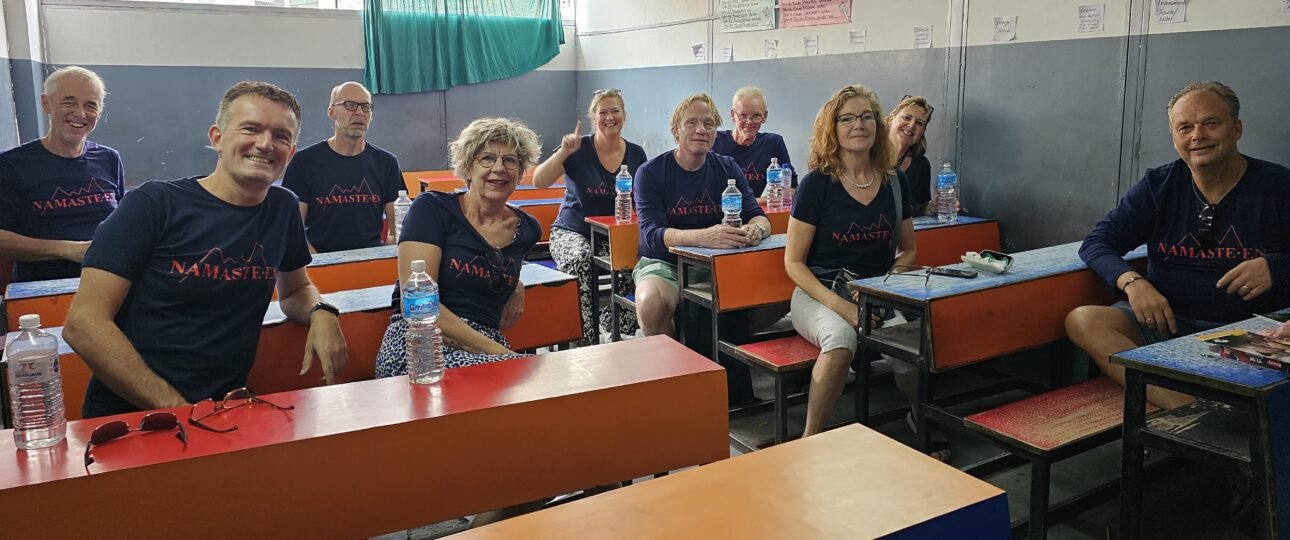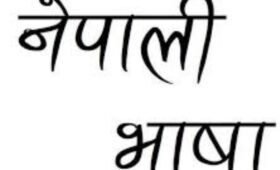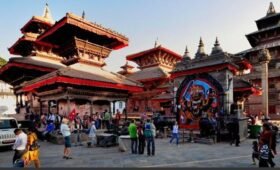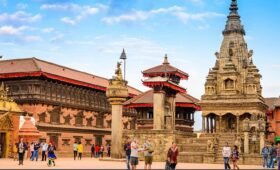Nepal’s captivating allure stems from its towering mountains and rich cultural heritage. The number of development workers, businesspersons, and tourists flocking to this enclave region nestled between China and India is steadily increasing. Despite its close proximity to these two culturally significant giants, Nepal maintains its distinct and inspiring character. Language plays a crucial role in this uniqueness, as Nepalese belongs to the Indo-Aryan language family and bears no resemblance to Tibetan or other Asian languages. Nepalese closely resembles Hindi and is easily comprehensible to Hindi speakers. The Nepalese people take great pride in their language and warmly welcome Westerners who express a desire to learn it.
Nepali, an official language of India, is not only spoken in Nepal but also holds significance as one of the 22 official languages of India. It belongs to the Indo Aryan segment of the Indo European language family. This language has been included in the 8th Schedule of the Constitution of India, specifically in the northeastern region. Additionally, Nepali has a profound influence on Sikkim, a state in India, and Darjeeling, a district of West Bengal. Recently, Nepali has been declared the official language of Darjeeling, and it is widely spoken by the people of Assam and Uttaranchal. Known as Gurkhali, Nepali is referred to as “the language of the Gurkhas” in Nepal. The history of Nepali is deeply rooted and traces back to the Indo Aryans, who were primarily settlers engaged in rice cultivation. Initially, it was known as Khaskura.
Nepali Language is widely spoken in the lower regions of the Himalayan range, making it one of the most predominately spoken languages among the Pahari languages. This language group is prevalent in areas spanning Himachal Pradesh and Uttarakhand states. Additionally, Nepali has influenced certain regions of Bhutan and Burma. It has also developed close associations with languages predominant in Tibet and Burma. Furthermore, Nepali shares a significant relationship with Hindi, and is often considered to be mutually intelligible to some extent. However, there are differences as well, particularly in its conservative approach towards derivations from the Sanskrit language, as well as certain English and Persian words, as opposed to Hindi-Urdu.
History Of Nepali Language
The language’s history can be traced back to approximately 500 years ago, when the Khas settlers migrated to the East and settled in the lower valleys of the Gandaki Basin. They specifically chose this region due to its suitability for rice cultivation. Notably, one of their extended families established a settlement in a small area known as Gorkha, situated between Kathmandu and Pokhara. In 1700, Prithvi Narayan Shah united various hilly tribes, including the Gurungs, Magars, and others, forming an army. This formidable force successfully conquered numerous small principalities located in the foothills of the Himalayan ranges.
As a result of the aforementioned expansion, which primarily occurred in the northern, western, and southern regions, the growing state found itself in conflict with both China and Britain. This conflict led to wars that ultimately resulted in the contraction of Nepal’s territory to its present-day borders. Despite this territorial reduction, both China and Britain recognized the strategic importance of Nepal as a buffer state and refrained from further attempts to diminish its land. Over time, Nepal emerged as a hub of political activity and a significant region extending beyond the Kathmandu Valley. Additionally, the language of Gurkha, known as Gorkhali, eventually evolved into Nepali.
Prithvi Narayan’s notable accomplishment was the successful capture of Kathmandu, a predominantly urban area situated in the eastern region of the Gandaki Basin. This region, known as Nepal at the time, became the new capital under Prithvi Narayan’s rule. From this strategic location, Prithvi Narayan and his successors expanded their territory towards the east, encompassing the Koshi basin to the north of the Tibetan Plateau, as well as the plains of North India to the south. Additionally, their influence extended westward across the Bheri/Karnali basin and beyond.
The original homeland of the Khas was eventually replaced by the Gorkha, establishing it as their political and military headquarters. The language Khashura was then transformed into Gorkhali, signifying the language of the Gorkhas. As Nepal emerged as a prominent political center, Gorkhali was later renamed Nepali. A copper plate inscription, dating back to 1280 B.S, serves as historical evidence of the Krachalya Kings’ triumph over the Kedar land of Gadawal, solidifying the Sija’s regime. Upon studying the aforementioned inscription, sources revealed that the Nepali language originated in Gorkha and Gadawal. Linguist records from that era, particularly those of Balkrishna Pokharel, indicate that the language was utilized during the Kirat era until 1382 B.S. This information was documented in a Maithali book titled “Barnaratnakar” by Simrangaud King Harisingh Dev, also known as “Pandit Jyotirishwor.”
Many centuries ago, before the unification of Nepal, the Nepali language was relied upon by kings and rulers of various nations for communication, as evidenced by records in a book. Additionally, the language was used extensively for writing treaties, sending letters, and making agreements. Even during the unification process led by Prithvi Narayan Shah, Nepali was the language of choice for communication with monarchs of other states, including baise, Limbuwan, Khumbhuhang, Chaubise, and Apungi. As a result, Nepali became the primary language for inter-caste communication.
There were numerous archives indicating that Prithvi Narayan Shah, prior to the unification of Nepal, utilized the Nepali language when conversing with Laxminarsingh Malla, the King of Kantipur, and his son, Pratap Malla. Additionally, there are various other pieces of evidence suggesting that the kings Jagat Prakash Malla, Bhupatendra Malla, Bhaskar Malla, Pratap Malla, and Jayaprakash Malla employed the language in all official correspondences. It is worth noting that before this period, the language was predominantly used by smaller states, but Prithvi Narayan Shah is credited with its widespread adoption during the unification campaign.
The historian Nayaraj Panta has provided numerous evidences indicating that the Nepali language served as the primary means of correspondence during the Malla dynasty. One such evidence is a stone inscription found in the Bishwonath Temple, constructed by Bhim Malla and written in Nepali. This inscription, dating back to the year 761 according to the Newari calendar, was discovered in a Dabali located in Kathmandu during the reign of Laxminarsingh Malla. These findings highlight the extensive historical usage of the Nepali language in the region, predating the efforts of Prithvi Narayan Shah.
Nepali is a language of great wealth.
Nepal possesses a wealth of language, resulting in a diverse range of notable literature. In the latter half of the 19th century, Sundarananda Bara authored the Adhyatma Ramayana in Nepali. Bhanubhakta is renowned for his rendition of the epic Ramayana in Nepali. Additionally, there exists a popular collection of folk stories known as Birsikka in the language. In more recent times, a version of The Holy Bible was translated into Nepali. Furthermore, the language boasts esteemed figures such as Poudyal, Devkota, and Sama, who have made significant contributions to Nepali literature. Presently, Nepali is written in the Devanagari script and is easily understood by speakers of Urdu and Hindi.
The Nepali language is spoken not only in Nepal but also holds prominence in India (specifically the North-Eastern part) and Bhutan. It can be traced back to the Indo-European, Indo-Aryan, Pahari, Eastern Pahari, and Indo-Iranian language families. The primary script utilized for writing Nepali is the Devanagri script.
The earliest recorded book written in the Nepali language, known as Tantrajkyan, dates back to the year 1518 AD. Similarly, the first Nepali song, titled Walangata Simule Swambaraya, was composed between the years 1523 and 1550 AD in the region of Pranmol Mila. Moving forward, the first one-act play in Nepali, named Ekadahi Brata, was performed in the year 1633 AD by Sidhhinarasingha. It is worth noting that the earliest drama records were produced by Jagat Prakash Malla, also known as Mooldev Shashidev in Nepali.
Nepali, like Hindi and Sanskrit, is written in the Devanagari script. Additionally, the language has historical records of using the Takri script, primarily in the western region of Nepal, Himachal Pradesh, and Uttarakhand. Nepal is also familiar with the Bhujimol and Ranjana scripts. The literary development in Nepal occurred within a relatively short period of approximately 100 years during the nineteenth century. The contributions of Pudyal, Sama, and Devkota, three esteemed figures, played a significant role in elevating the status of Nepali to that of other global languages.
What is the number of individuals who speak Nepali?
Approximately one-third of Nepal’s populace communicates in their native language.
Approximately 27 million individuals worldwide speak the language, with around 21 million residing in Nepal, as reported by the 2021 Census. Nepali is predominantly spoken in the hilly regions of Nepal and throughout the South Himalaya. Pahad, situated in the western part of the country, serves as the primary region where this language is spoken. Nepali is now widely utilized, including within the government. It serves as the native language for the country’s expanding population and is exclusively employed in its courts.
It has been approximated that approximately 35% of Bhutan’s population, including displaced Nepalese refugees, speak Nepali. The ethnic population speaking the language is estimated to be between 30% and 40%, with a significant majority residing in the South. Additionally, there is a substantial number of Nepali speakers in India, with over 500,000 individuals in the Sikkim and Darjeeling regions. In the Jalpaiguri district of West Bengal, there exist other individuals who speak the Nepali language. The estimated number of Nepali speakers in Jalpaiguri and Darjeeling is approximately 1,400,000. In the North Eastern region of India, which encompasses the seven states of Assam, Nagaland, Meghalaya, Mizoram, Tripura, Manipur, and Arunachal Pradesh, there are millions of individuals who communicate in Nepali. Furthermore, a significant number of Nepali speakers have settled in the metropolitan and cosmopolitan cities of Delhi, Kolkata, Bangalore, Chennai, Mumbai, Hyderabad, Chennai, and Visakhapatnam. As of 2006, the recorded number of individuals who speak Nepali as their mother tongue is around 20 million.
Hence, based on the aforementioned information, it becomes apparent that Nepali holds a prominent position as both a widely spoken and revered language among Nepalis. This is not limited to Nepal alone, but extends to various locations where Nepalis have established themselves. Moreover, Nepali boasts a profound cultural heritage and a traditional past.
Nepali Language Class In Nepal
The Nepali language holds the esteemed position of being both the national and official language in Nepal, and it is extensively utilized throughout the entirety of the Kingdom of Nepal. This language itself offers individuals a unique and unparalleled experience. It is widely recognized that without acquiring a firm grasp of the language, it may be difficult to ensure a successful and enjoyable stay and travel experience. A diverse range of individuals, including expatriates, business professionals, tourists, and volunteers, come to Nepal with the purpose of engaging in various activities such as serving the local community, conducting business, and working in national and international organizations. As a result, they require a comprehensive understanding of the Nepali language, culture, and society. Real Journey Nepal is dedicated to supporting these expatriates, business professionals, volunteers, and research students by offering Nepali language classes and cultural training. This initiative aims to facilitate their acquisition of not only the Nepali language but also other indigenous languages, while also providing valuable insights into the vibrant Nepali culture and society.
Real Journey Nepal has highly qualified and experienced Nepali Language Tutors and up-to- date learning materials. The Language Tutors have had many years’ experience teaching expatriates for the United Mission to Nepal (UMN), the International Nepal Fellowship (INF) and the Nepal Leprosy Trust (NLT) and teaching American university students.



